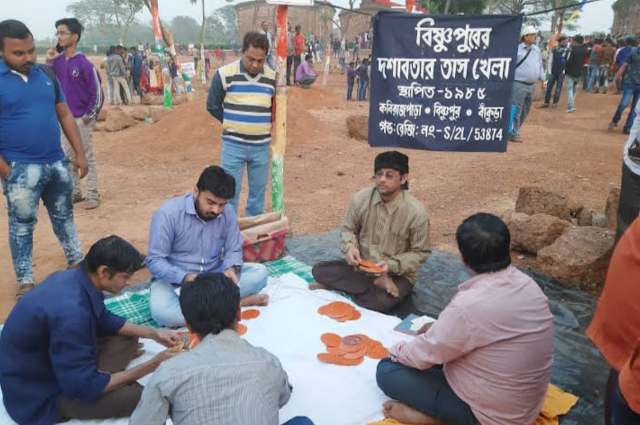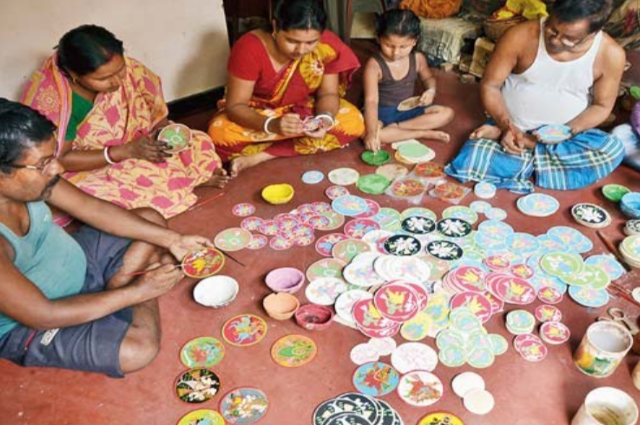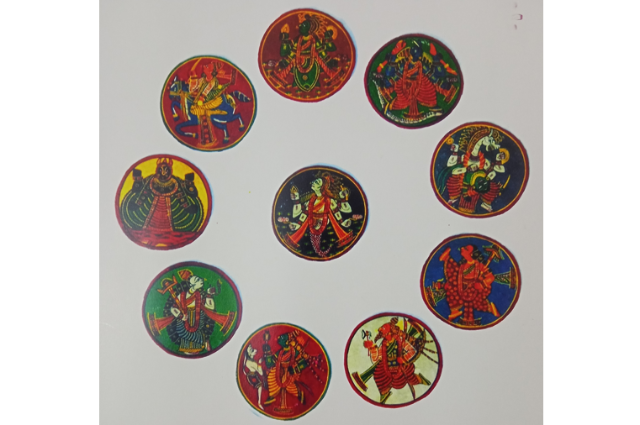
Introduction:
More than thirteen hundred years ago Malla Dynasty, popularly known, was founded by the king named Adi Malla (694 CE – 710 CE) in the western part of Bengal. Erstwhile Mallabhum, the kingdom ruled by the Malla kings of Bishnupur, mainly flourished to its zenith during the reign of Hambir Malla Dev popularly known as Veer Hambir (1565 to 1620 CE), the 49th ruler of the Malla Dynasty. He was a contemporary of the Mughal emperor Akbar. Enthralled by the recitation of the Bhagavata by Srinivasa Acharya, Hambir converted from Saktaism to Vaishnavism and Madan Mohan, another name of Lord Krishna, became the tutelary deity of the Malla dynasty. Under the keen patronage of Veer Hambir and his successors Bishnupur became a prominent seat of art, music and culture to enrich Bengal. The reign of Veer Hambir is called the golden period of the Malla Dynasty.
A Recreation Sans Malice:
The influence of non-violence advocated by the Vaishnavism perhaps cast a spell even in the popular pastime and recreation during that period. Hunting was replaced by the rigorous practice of music that richly contributed to the creation of the famous Bishnupur Gharana. Another form of recreation was of course playing cards that gave birth to the unique Dasavatara Taas (10-incarnation cards).
Innovation of the Game:
According to the pundits the concept of Dasavatara card was derived from Mughal Ganjifa that had been played by the Mughal emperors. The 8-suit pack of Mughal Ganjifa comprising 96 cards morphed into 10-suit pack of Dasavatara Taas of 120 cards with the images of ten incarnations of Lord Vishnu most probably in tune with the Vaishnavism. It is also believed by many that the king Veer Hambir influenced by Srinivs Acharya took initiative to bring the game of Dasavatara Taas from the royal court of Orissa. This opinion is strongly vindicated when Lord Jagannatha instead of Lord Buddha is considered the ninth incarnation in the game. But the card game underwent some changes. A pack of Dasavatara Card of Orissa contained 144 cards and gods including Ganesha and Kartika would also be inscribed as the incarnations of Lord Vishnu.
Artists and the Art:
The then renowned ‘Patachitrakar’ (canvas & scroll painter) Kartick Fouzdar was entrusted with the onus of preparing the Dasavatara Taas. The great Fouzdar family despite financial constraints due to plummeting demands of the Dasavatara Taas in the market is still endeavoring to keep this traditional art form of Bishnupur alive. The making of the Dasavatara Taas entails a good deal of artistic skills, hard labor, dedication, patience and above all passion. It is undoubtedly a unique illustration of the folk art of Bengal.
Multi-layered cloth pieces pasted with ingeniously prepared tamarind glue are used as canvas to prepare Dasavatara Taas. The multi-layered canvas is cut into circular sizes. Delicate brushes made of the hairs from goats’ tails are used because of their excessive potentiality to contain the liquid colors for long. Variety of colors mostly derived from natural sources like raw tamarind, green leaves of ‘Sami’ trees, red and white stones, ‘nil bari’ (indigo tablet), charcoal, lampblack soot, vermillion and so on are used to draw and paint the figures on the cards.
Dasavatara Card Games

Description of the Cards:
The 10 suits of the Dasabavara Taas consist of 10 incarnations of Lord Vishnu. They are Matsya (the fish), Kurma (the giant tortoise), Varaha (the boar), Nrisingha (the man-lion), Vamana (the dwarf), Parashurama (the warrior with the axe), Rama (the king of Ayodhya), Balarama (the elder brother of Krishna), Jagannatha (Lord Krishna in place of Lord Buddha) and Kalki (a great warrior).
Value of the Cards:
There are 12 cards including ‘Raja’ the King and ‘Ujir’ the Minister in every suit represented by an incarnation of Lord Vishnu. In the cards denoting the King, the full figure of the concerned incarnation is painted with a pavilion. On the other hand, the card representing the Minister is also painted with full figure of the related incarnation but without pavilion. Other 10 general numerical cards are marked by 1 (tekka), 2 (duri), 3 (tiri), 4 (chouka), 5 (panja), 6 (chakka), 7 (sat), 8 (aat), 9 (noy) and 10 (ash) respectively. In every suit Raja (the king) is the first control card and Mantri (the minster) the second control card. Every suit of the Dasavatara Taas is symbolized by different signs and different control cards. They are charted in the following table.
| Incarnations | Symbols | Other Control Cards |
| Matsya | Fish | From 10 (daas) to 1 (tekka ) |
| Kurma | Tortoise | Do |
| Varaha | Conch Shell | Do |
| Nrishingha | Chakra/Red Flowe | Do |
| Vamana | Water Ern | Do |
| Rama | Arrow | From 1(tekka) to 10(daas) |
| Balarama | Club | Do |
| Parashurama | Axe | Do |
| Jagannatha | Lotus | Do |
| Kalki | Machete | D0 |
How to Play the Game:
The game of Dasavatara Taas is played with five players. Unlike other card games there is no system of partnership. They are all individual contenders. Four cards are distributed at a time to each player. Every player gets 24 cards. The game runs both clockwise and anti-clockwise as per the will of the players. Generally, the game runs anti-clockwise. The game may be commenced with any of the five incarnations as the starter determined by the times and the weather of the day of playing.
The commencing suits of incarnations that vary are given in the chart:
| Time/Weather | Starter Incarnation |
| Day Time | Rama |
| Evening or Dusk | Nrisingha |
| Night | Matsya |
| Dawn | Jagannatha |
| Rainy Time | Kurma |
After getting 24 cards, the seat of the first incarnation is adorned with the numerical card 7 of Parashurama, 8 of Kalki, 9 & 10 of Jagannatha. The concerned incarnation is placed on the seat at the beginning of the game. The first incarnation holder is entitled to enjoy the advantage of commencing the game as per his convenience. As the first incarnation holder he possesses 2 tricks. In the game of Dasavatara Taas there are 24 tricks in all.
The base point of this game is 24. One trick comprises 5 points. Therefore, 5 tricks are equal to (5 X 5) i.e. 25 points. If a player obtains 25 points, he wins the deal by (25 – 24) i.e. 1 point. On the other hand, a player winning less than 5 tricks is considered looser. As for example, if a player possesses 4 tricks, he obtains (5 X 4) i.e. 20 points. Therefore, he is defeated by (24 - 20) i.e. 4 points. Then the game continues with another deal and so on.
Symbolic Terms:
There are some symbolic terms widely used in the game of Dasavatara Taas. They are ‘giving chillic’ (distribution of cards), ‘dast’ (a trick of a deal), ‘serwa’ (giving option to other players to hold the game with specific control card aiming to free next control of that card), ‘boj’ (pack),’tipsai’ (a clamor given by the immediate left player of the first holder after ‘serwa’ and the former is entitled to hold the game acquiring 2 tricks. ‘satip’ (single finish), ‘jortip’ (double finish),’hatsai’ (dropping of the extra cards on the board after 15 tricks played in the deal as a player is entitled to maintain only 9 cards for the remaining tricks) and ‘jore bhanga’ (to take other tricks in hand to free other cards by giving ‘serwa’) and so on. These symbolic terms are acquired through regular practice.

Verse on the Game:
In this regard a Bengali verse composed by late Sanatan Das, a renowned Dasavatara Taas player deserves special mention. In his folk verse, he had precisely but clearly narrated the rules of the game. His recitation of the verse on the terrace of the famous Shyamray Temple (a temple of five minarets) was broadcast in Akashvani Kolkata. I would like to, if I may, attach the original verse in Bengali and roughly translate the verse in English below:
Verse on the Game of Dasavatara Taas
Dasavatara Game on the Way to Extinction:
If the Dasavatara Taas are still available in the market, the game of these cards is on the way of extinction. A good many reasons may be identified behind this. First, the advent of English playing cards with the options of playing variety of games nudged the game of Dasavatara Taas. Secondly, the complex rules and regulations of the game of the Dasavatara Cards could not perhaps attract ordinary plebeians so much as the European cards could. Thirdly, the players find it difficult to handle a large number of obese and round-shaped Dasavatara cards, whereas, slim and oblong European cards are easy to use. Now these cards are bought and preserved by people merely as a collection of art goods. The principal purpose of the creation of Dasavatara Taas is almost passing into oblivion.
The king of Bishnupur late Kalipada Sinha Thakur almost regularly arranged the game of Dasavatara Taas with the players including late Niranjan Kundu, late Bhajahari Dey, late Jatadhari Chakraborty, late Badal Das, late Guiram Giri, late Kishori Mohan Dasgupta, late Ajit Kumar Karmakar, late Satish Ghosh et al. Besides, the game of Dasavatara Taas would have been played regularly at Shankhari Bazar, Mansatal and Krishnaganj, the older localities of Bishnupur, a few decades ago. For want of the players the games of Dasavatara Taas are not arranged regularly. The game is still exhibited during Bishnupur Festival under the aegis of the players like Mr. Ranjit Karmakar, Mr. chanchal Karmakar, Mr. Sourav Karmakar, Mr. Manas Das, et al. The Dasavatara Card Players Association was established in 1985.
To Regain the Glory of the Game:
Now the exquisite form of art of Dasavatara Taas is in the limelight. But the game of cards that was the main purpose behind the creation of the art has been put on the backburner. The game of Dasavatara Taas is declining critically with the ever-denuding number of players. Needless to say, if the game is revived, the art of Dasavatara Taas will automatically persist with vigor. At least, with the help of the existing players government should publish multilingual books with illustrations elucidating the rules and regulations of the game of Dasavatar Taas in detail for those who are interested in it. Above all, such a positive initiative if adopted will surely save the game from possible extinction before long.
